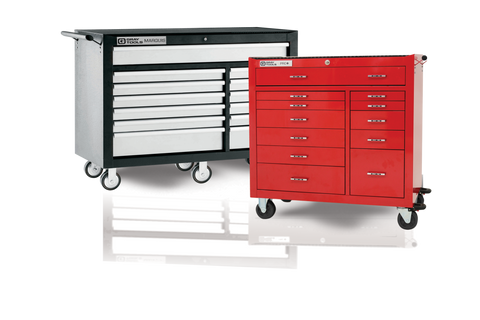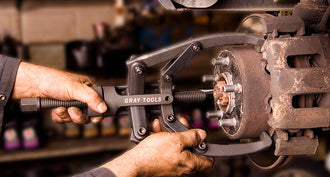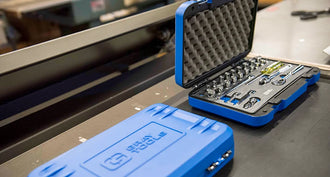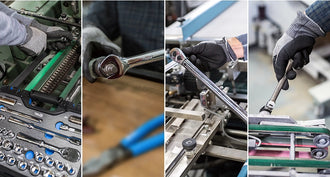Shopping For a New Tool Chest? Here Is What You Need To Know (Part 1: What Makes a Quality Box)
- Gray Tools Official Blog
- 03 Feb, 2017
 If you waste a lot of time searching through worktables, closets, boxes, tool holders, or pouches trying to locate a tool, it is time to consider purchasing a tool chest.
If you waste a lot of time searching through worktables, closets, boxes, tool holders, or pouches trying to locate a tool, it is time to consider purchasing a tool chest.
The same holds true if your current tool chest has exceeded its storage capacity. Depending on its condition and your space constraints, you might want to consider buying an additional one or a replacement that will provide room for your existing tools and enough space to grow your collection.
The most popular option professionals choose to house their tools is a roller cabinet or mobile workstation. A roller cabinet is a toolbox on wheels that can provide centralized, easy-to-access storage for the tools you have collected over the years.
It consists of a metal frame that holding a number of drawers, and four or more casters mounted at the bottom of the frame for easy maneuvering.
For the do-it-yourself that only owns a few basic tools, a light-duty, budget friendly roller cabinet will do. However, if you are professional with an already impressive tool collection that only grows bigger year after year, the quality, and durability of the roller cabinet should be a priority.
Although an exterior design might look attractive and “muscular” at first glance, “it’s what’s inside” that matters when it comes to storing your tools safely and conveniently. The long-term durability of a roller cabinet is determined by the quality of material and components and the production workmanship and assembly.
Before we take a more in-depth look at the main components of a roller cabinet, we need to understand that the words “quality toolbox” have different meanings, depending on the owner and intended application.
For example, if you need to move the toolbox a lot, investing in quality casters is necessary. If your toolbox will be mostly stationary but it needs to hold many tools, then heavy-duty construction might be what you need.
Before you start shopping for your next roller cabinet, try to answer these questions as best you can:
- What is the approximate total weight of the tools your new tool chest will need to hold?
- How many oversized/bulky tools you need to store?
- What is the floor surface you will be placing and moving your roller cabinet on?
- How often will you move the roller cabinet?
- What is the intended use of the top area of the roller cabinet? Drawing, working, holding additional tool storage?
- Do you need any power outlets as part of the roller cabinet?
- What are the chances of your tools being stolen at your workshop?
Frame
The frame also referred to as the chassis is the “foundation” of any roller cabinet supporting the other components, namely the drawers and casters. As the foundation, it must resist gravity, which pulls the weight inside the tool chest downward, and racking forces, which are X, Y & Z axis movements caused by stresses and expansion.
Racking forces are encountered when moving the roller cabinet across on uneven floors, or rolling over bumps. The result is a box that loses its level or plumb. A frame damaged from racking will show signs of caved or dented sidewalls, drawers that will not open/close and collapsing of the work top.
Below we will explore several elements to look for in your next purchase that can limit the effect of damaging gravitational and racking forces:
The gauge of steel used in its construction is critical. The typical gauge of steel used to build the frame falls into the 14-22G range. The lower the number, the thicker, and more durable the material. A roller cabinet made with 16G steel is more durable than one made of G20 steel.
Manufacturers often use different gauges of steel for various sections of the frame. For example, 16G steel for the top and bottom, and 18G or 20G for the sidewalls, posts, and channels.
The gauge of steel used is generally reflected in the net weight of the tool chest. All other things being equal, the heavier the box, the thicker the gauge of steel used in its construction.
The total number of welds (weld count) can have big impact of long-term durability. While spot welding is a universally accepted production method of joining two pieces of metal, what is not universal is the number of welds required.
An inferior quality frame will have fewer welds. This means there are fewer bonds, spaced further apart holding the frame pieces together. The easiest way to spot the number of welds is by simply removing drawers from frame and looking inside.
Reinforcements such as corner posts, C-channels, and extra walls added inside the frame are also excellent indicators of superior quality. That said not all reinforcements are equal. To determine if the frame has reinforcements and to evaluate their quality, remove several drawers to gain access to frame. Once removed inspect for quantity, steel thickness, size and placement of the reinforcements.
Less obvious but equally important considerations include:
|
Construction Type |
Weld Joint Types |
|
· Single, Double or Triple Wall · Post Design · Roll cage |
· Butt Joint · Corner Joint · Edge Joint · Lap Joint · Tee Joint |
As with many things, each construction and weld joint type has its advantages and disadvantages. Take the time to investigate before buying. As a general rule of thumb look for double or triple wall construction, designs with as few seems as possible, and primarily lap joint welds.
In future posts in this series we will look at other key components such drawers, slides, locks and casters.



